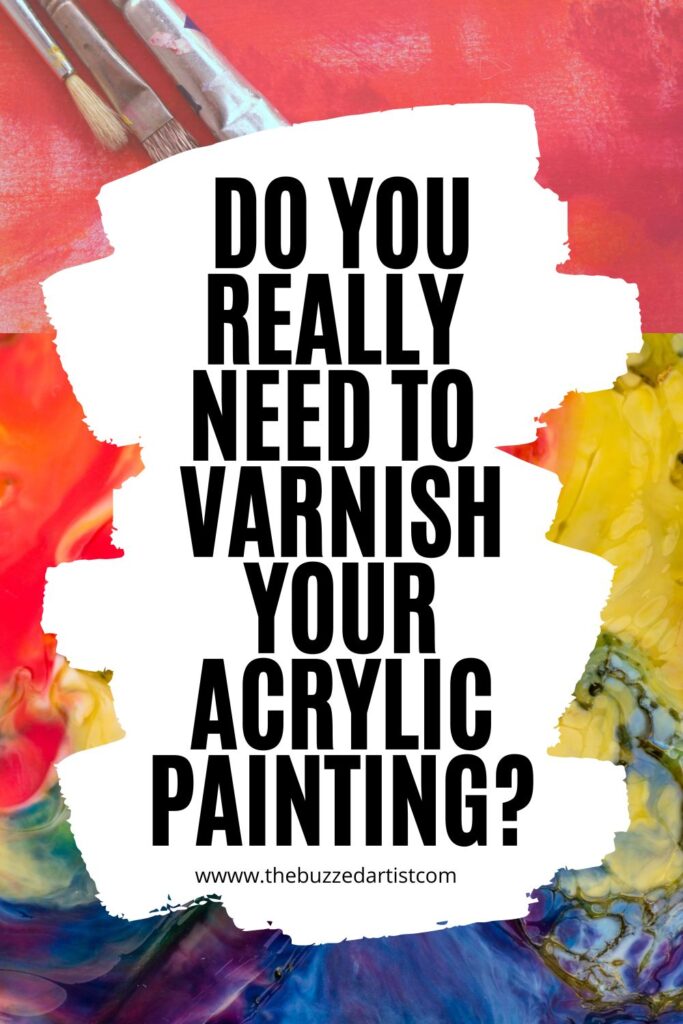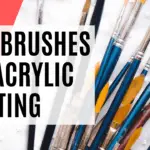Is it totally necessary to varnish an acrylic painting? Here’s a few pointers to help guide your decision.
You just completed your latest acrylic masterpiece. You set your brush down and happily gaze upon your work; but just as you’re about to pop open that bottle of merlot in celebration (it’s 5 o’clock somewhere, right?), a tiny annoying question begins to form in your mind. Do I need to varnish this painting? Is it really necessary?
and like many things in art….the answer to that question depends on your intentions.

Is varnishing really necessary? Well, no, not really.
Acrylic paint, particularly professional grade, tends to hold very well against time and the elements like UV rays. However, there are some added benefits for varnishing that you may want to consider before gulping that entire wine bottle and declaring victory.
Disclaimer: some links used in this post are affiliate links, which means I’ll earn a small commission if you purchase using my links at no extra cost to you. I only recommend products I think will be helpful to you and bring you one step closer to creating beautiful acrylic masterpieces!
1. Helps deepen or saturate the colors on the canvas
If there is one thing that pro-varnish artists rave about is how varnishing creates a deeper, richer vibrant color version of their painted acrylic. And if that is something you are looking to do with your work, then varnishing should be considered an option to pursue.
But, if you carefully crafted your paint to look a certain way, and you fear touching it may alter the work negatively, then don’t use varnish. It just ain’t worth the heartache.

2. Prevents Dirt Buildup and UV penetration
When acrylic paint dry, it may seem like the surface itself is super smooth. However, that cannot be further from the truth. Dried acrylic paint, topologically speaking, is actually very bumpy, with lots of hills and valleys due to the paint seeping into the canvas crevices or whatever uneven surface it lies upon. Not to mention your brush strokes do like to leave tiny indents here and there. This uneven surface is the perfect little home for dirt and dust to live in and makes for a very challenging cleaning experience.

When varnish is used on a painting, a coat is applied that evens out the surfaces, filling in all the super tiny crooks and crevices of your painting surface. This will prove super helpful in the years to come because you can simply use a damp cloth to wipe and clean the varnish surface, helping your painting look like new again.
Plus, varnish can help slow down the color degradation of your acrylics due to UV light exposure. Of course, if you’re painting lives inside a book or barely ever sees the light of day, then you won’t need to really worry about this so much. But, like most of us, we like to see or sell our paintings for the world to admire, so ensuring they can last for decades without losing their color vibrance is a good thing.
3. Extends the lifetime of your painting
Like all physical things in life, nothing really lasts forever.
As much as we hate to admit it, the hours we poured into a painting can be lost to the dredges of time and degradation. Plus, when left unprotected, attempting to wash or touch your acrylic painting may chip it or even come completely off! No bueno.
Varnish can help extend the lifetime of your paintings, a big part because it preserves the colors better and helps create little-to-no interference when it comes to cleaning and maintaining it. Basically, the less you have to touch the original part of the painting itself, the longer and more resilient that painting will be.
Another way to think of it is like this: if you have had a painting in your family for a long time and want to restore it back to its original state of vibrancy, you would have much greater success if the painting has been varnished versus not. If you want that restoration option at any point, then you’ll want to consider using varnish.
4. Creates an even sheen over the entire surface
Have you ever seen inconsistencies on the surface of your painting? Like some areas appear glossier or shinier than others, either because you reapplied another layer of paint somewhere that may have been glossier than another layer of paint? Long story short, no matter how you turn your canvas, you notice an imbalance of proper light reflection and it kinda bothers you a little bit.

This is where using a varnish can actually come to the rescue.

Adding a layer of varnish can even out the surface reflection, giving your eye a more unified viewing experience. If that is what you’re looking to achieve, you’ll probably want to varnish.
Now, comes the bigger question….what type of varnish sheen should you choose? And more importantly, will it affect the overall painting?
Once again, the answer here is a bit ambiguous, so let’s dive into this a bit more.
When it comes to choosing various varnish sheens, there are 3 big contenders: glossy, matte, and satin finish. Each of these have their ups and downs in terms of overall painting aesthetic.
As further demonstration, here are the different sheen effects of matte, satin and gloss over the color black. Do you notice the differences between the three?

Glossy Varnish
Glossy varnish, as the name suggest, gives your paintings a glossier, shinier finish – similar to what you would typically see in magazines. There is more light reflection, the colors “pop” more, and dark colors like black are intensified. Basically, if you are looking to create more contrast in your colors and don’t particularly like how matte your paints look, then applying a glossy varnish is a great solution.
Matte Varnish
Matte varnish is practically the opposite effect of glossy varnish. It contains a white matting agent which when dried creates a smoother, less-reflective surface. Unlike it’s glossy cousin, matte varnishes do not completely dry transparent and can flatten out your colors to a slightly duller sheen; for example dark colors like black will look a bit more grayed out, thanks to the not-so-transparent white matting agent. Once again, if that is your overall intent or you don’t really mind, then yes, lean into that matte varnish.
Satin Varnish
Lastly, but not least, satin varnish is a go-to varnish sheen that many artists like to use – mainly because it isn’t as glossy and brash as gloss varnish but it isn’t as dullified as matte varnish. It sits nicely in between the two sheens. Your colors won’t appear as high in contrast, however, they won’t feel dulled down either. In fact, some artists report adding satin varnish adds that little extra “zing” to their paintings.
What are some other alternatives?
Of course, using a varnish isn’t the only option to protect your paintings.
If you’re still not quite convinced that varnishes are the right call for you, or you just want to let your paintings sit for a while so you can do rework or touch-ups, you may want to consider using an acrylic sealer. Using acrylic sealers can help to fill in the tiny holes and crevices in your acrylic painting and prevent dirt buildup. Plus, sealing in your colors can help protect those colors from direct UV exposure, helping those colors last longer than if left to their own devices.
Another alternative would be to just leave your painting as is, without applying varnish. There isn’t a hard and fast rule saying you HAVE TO varnish. It really is a means to protect your painting so it can last for many lifetimes.
But left on its own, dried acrylics can last a generation or two, especially if you got good quality paint to get you there. It may gather up some dirt along the way, which can be a challenger to clean, but if you like that kind of look, then skip the varnish.

What if I am still unsure if I want to varnish or not?
That’s ok too. Sometimes, you just need to see it for yourself. If you are debating between the three types of sheens or aren’t sure how a particular varnish will look like on your painting, I would suggest doing a sample test on either a small corner of your painting, on a test painting, or on paint samples.

Once the varnish dries (which usually takes 1-2 days), take a look at how the painting looks to you. If you absolutely hate the effect or prefer one sheen over another, then you are much better equipped to make that decision for yourself.
What do you like to use?
I have gotten this question quite a few times and in an effort to answer you honestly, I am 50-50 on using varnish. When it comes to my painting tutorials, I don’t typically varnish those paintings. I’m not looking to pass these down to my family members any time soon, plus I do like the possibility of reusing them for future tutorials.
But, when it comes to commission work or any paintings I sell, I do add a removable spray matte varnish to help seal the paint. Personally, if I am giving a client or customer a painting, I assume they want that painting to last them for many generations. Perhaps it’s the people-pleaser in me, but that is how I typically like to roll.
- Practice and tutorial paintings = no varnish. Get the wine!
- Commission paintings = varnish that ish!
All in all, I hope this helps you make an informed decision the next time you are completing your next acrylic masterpiece.
What do you think about varnishes? Are they necessary? Which ones are your favorite? Comment and share below!





